Economics for Managers: Market Structures and Efficiency
Added on 2023-06-12
24 Pages4446 Words206 Views
Running Head: ECONOMICS FOR MANAGERS
Economics for Managers
Name of the Student
Name of the University
Course ID
Economics for Managers
Name of the Student
Name of the University
Course ID
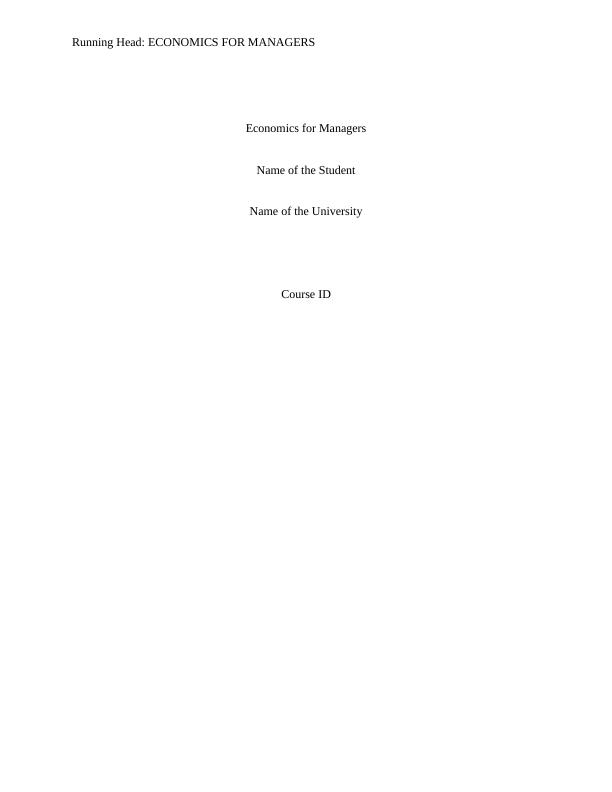
1ECONOMICS FOR MANAGERS
Part A
The economc definition of market structure differs from that understood by marketers.
Marketers view market as competetive device and hence focuses on only marketing strategies or
plan. Economists on the other hand comsiders the overall structure of market beyond only
competition with an attempt to analyze and anticipate behaviours market participants. The
concept of market in economics thus extended beyond just a simple place of exchanging goods
and services (Goodwin et al., 2015). The four common form of market structure based on
number of participants in the market include perfectly cometitive market, monopoly, oligopoly
and monopolstic competition.
Oligopoly
The oligopoly market is a representative market structure containimg small number of
competiting firm with each enjoying a relatively large size in the market. High level of
concenration is an obivios feature of oligopoly market. Firms in the oligopoly market do not
have large number of competitiors. Rather there are intense competition among the few large
firms. Each firm keeps a close look on strategy of its rival firms (Baumol & Blinder, 2015).
Strategy of the firms are interdepenent on each other. For this, if one firm decide to lower price
to increases its share of market the competiting firms follow the same and this iften results in a
price war in the market place. Apart from price competion firms in this form of market are
engage in non-price competition in terms of product differentiation, investment in advertisimg
and others.
The oliopolistic firms need to take decision regarding price and competition. The firms in
the market place decides whether to compete with other firms or to agree on a mutually
Part A
The economc definition of market structure differs from that understood by marketers.
Marketers view market as competetive device and hence focuses on only marketing strategies or
plan. Economists on the other hand comsiders the overall structure of market beyond only
competition with an attempt to analyze and anticipate behaviours market participants. The
concept of market in economics thus extended beyond just a simple place of exchanging goods
and services (Goodwin et al., 2015). The four common form of market structure based on
number of participants in the market include perfectly cometitive market, monopoly, oligopoly
and monopolstic competition.
Oligopoly
The oligopoly market is a representative market structure containimg small number of
competiting firm with each enjoying a relatively large size in the market. High level of
concenration is an obivios feature of oligopoly market. Firms in the oligopoly market do not
have large number of competitiors. Rather there are intense competition among the few large
firms. Each firm keeps a close look on strategy of its rival firms (Baumol & Blinder, 2015).
Strategy of the firms are interdepenent on each other. For this, if one firm decide to lower price
to increases its share of market the competiting firms follow the same and this iften results in a
price war in the market place. Apart from price competion firms in this form of market are
engage in non-price competition in terms of product differentiation, investment in advertisimg
and others.
The oliopolistic firms need to take decision regarding price and competition. The firms in
the market place decides whether to compete with other firms or to agree on a mutually
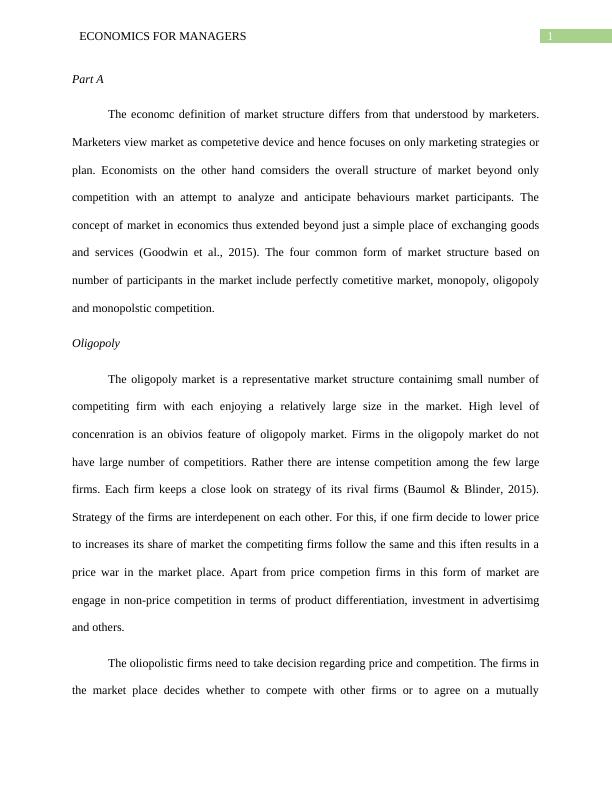
2ECONOMICS FOR MANAGERS
beneficial understanding. When firm in the oligopoly market takes their joint decision about
price and outout combination then they it is called collusive oligopoly. In contrast, if the fims
decode to compete with each other then it is called non-collusive oligopoly (McKenzie & Lee,
2016). Firms in a pure oligopoly market sell homogenous products while firms in differentiated
oligopoly sells heteregenous or differentiated product.
Monopolistic Competition
The monopolistically competetive market structure has several small firms in the market.
The firms in the monopolistically competitive market exercise a freedom to enter or exit the
market. Each firm in the market has large number of competitors with each sellling a
differentiated product. Each seller in the market takes decision of price and outpt if its own
product indepent of other competitors. The seller in the monopolistic competition thus enjoy
some degree of monopoly power over its own product (Friedman, 2017). Again they face intense
competition like the perfectly comprtitive market. The monopolistically competitive market thus
is comsidered to have characteristics of both monopoly and perfectly comprtitive market.
One exclusive feature of monopolistic competition is product differentaition. Each seller
in the market tries to make its own product as much different as possiblr from its competitors.
With product differenatition firms attempts to make its perceive demand curve less elastic. Aprt
from physical product differentiation firms also engage in marketing differentiation,
differentation of human capital or differentiation in the distribution. The mnopolistically
competitive firms faces a downward sloping demand curve as they are able to chragge a higher
or lower price than its competitors (Moulin, 2014). However, because of availability of close
substitute firms usually do not engage in such price competition. Rather they focus on
advertising, brand promotion or other forms of non-price competition.
beneficial understanding. When firm in the oligopoly market takes their joint decision about
price and outout combination then they it is called collusive oligopoly. In contrast, if the fims
decode to compete with each other then it is called non-collusive oligopoly (McKenzie & Lee,
2016). Firms in a pure oligopoly market sell homogenous products while firms in differentiated
oligopoly sells heteregenous or differentiated product.
Monopolistic Competition
The monopolistically competetive market structure has several small firms in the market.
The firms in the monopolistically competitive market exercise a freedom to enter or exit the
market. Each firm in the market has large number of competitors with each sellling a
differentiated product. Each seller in the market takes decision of price and outpt if its own
product indepent of other competitors. The seller in the monopolistic competition thus enjoy
some degree of monopoly power over its own product (Friedman, 2017). Again they face intense
competition like the perfectly comprtitive market. The monopolistically competitive market thus
is comsidered to have characteristics of both monopoly and perfectly comprtitive market.
One exclusive feature of monopolistic competition is product differentaition. Each seller
in the market tries to make its own product as much different as possiblr from its competitors.
With product differenatition firms attempts to make its perceive demand curve less elastic. Aprt
from physical product differentiation firms also engage in marketing differentiation,
differentation of human capital or differentiation in the distribution. The mnopolistically
competitive firms faces a downward sloping demand curve as they are able to chragge a higher
or lower price than its competitors (Moulin, 2014). However, because of availability of close
substitute firms usually do not engage in such price competition. Rather they focus on
advertising, brand promotion or other forms of non-price competition.

3ECONOMICS FOR MANAGERS
Both the above discussed market structures represent imperfect competition. These two forms of
markets are however differs in a number of ways. The key factors distingusing oligopoly and
monopolistic competition are given below
Number of sellers
The oligopoly market is characterized as having a few large sellerswhile in the
monopolistically competitive market there present a large number of small sellers (Rader, 2014).
Because of dufferences in number of sellers the degree of competition differ in the two form of
market.
Market size and market control
Difference in the two firm of market exists in terms of their relative size and market
control devised by each of these firms. There is though no speific size to clearly defining the two
form of market but in general a monpolistically competitive firm is relatively large in size as
compared to an oligopoly market. Because of presence of large number of firms in the market,
the market share is divided between these firms with each having a relatively small share in the
market. As each firms have a small market share decision of any signle firm does not have much
impact on the entire market (Stoneman, Bartoloni & Baussola, 2018). The oligopoly market on
the other hand is chsaracterized by dominance of few large sellers. The sellers in the oligopoly
market enjoy a considerble share of market and thus devices a greater control in the mrket.
Entry barriers
The incumbant firms in the oligopoly market maintains a high barriers to entry of the new
firms in the market. The need for government authorization often acts as a major entry barrier in
the market. Government often limits the number of competitors in the oligopoly market. Apart
Both the above discussed market structures represent imperfect competition. These two forms of
markets are however differs in a number of ways. The key factors distingusing oligopoly and
monopolistic competition are given below
Number of sellers
The oligopoly market is characterized as having a few large sellerswhile in the
monopolistically competitive market there present a large number of small sellers (Rader, 2014).
Because of dufferences in number of sellers the degree of competition differ in the two form of
market.
Market size and market control
Difference in the two firm of market exists in terms of their relative size and market
control devised by each of these firms. There is though no speific size to clearly defining the two
form of market but in general a monpolistically competitive firm is relatively large in size as
compared to an oligopoly market. Because of presence of large number of firms in the market,
the market share is divided between these firms with each having a relatively small share in the
market. As each firms have a small market share decision of any signle firm does not have much
impact on the entire market (Stoneman, Bartoloni & Baussola, 2018). The oligopoly market on
the other hand is chsaracterized by dominance of few large sellers. The sellers in the oligopoly
market enjoy a considerble share of market and thus devices a greater control in the mrket.
Entry barriers
The incumbant firms in the oligopoly market maintains a high barriers to entry of the new
firms in the market. The need for government authorization often acts as a major entry barrier in
the market. Government often limits the number of competitors in the oligopoly market. Apart
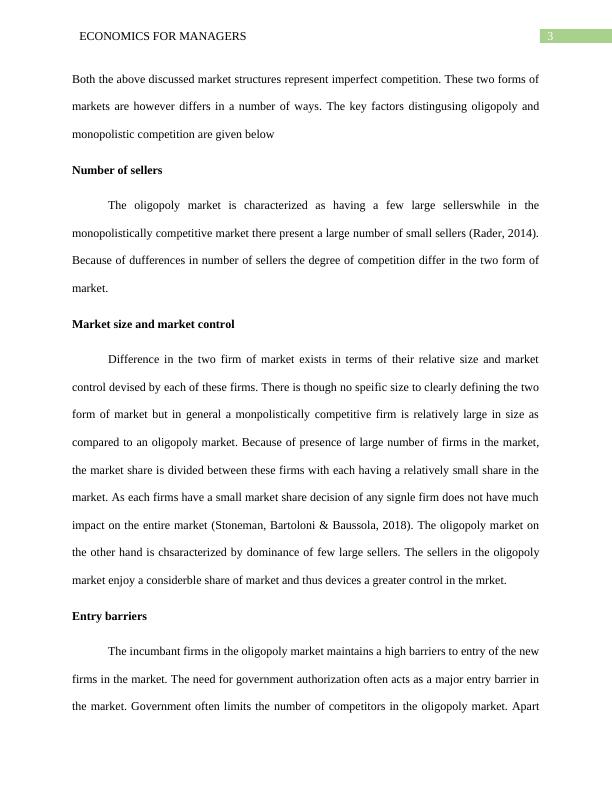
4ECONOMICS FOR MANAGERS
from government regulation there exists other forms of barriers as well. The existing firms might
enjoys exclusive owenership over a specific input. With lack of access to such input new firms
cannot enter the market. The presence of high fixed cost likely to discourage new seller to enter
the industry (Cowen & Tabarrok, 2015). The exising firms enjoys advantages of economies of
scale which help them to recover huge fixed cost. The new entrants however cannot have the
benefits of economies of scale and hence fear to enter the industry.
The entry or exit in a monopolostically competitive market is less cumbersome process.
Depending on the short run profit or loss firms decides whether to enter or exit the market. The
economic profit in the short run encourages new firm to enter while in presence of economic loss
firms leave the the industry.
State of equilibrium in monopolistically competitive market
Short run
Firms in any form of market have the common objective of maximizing profit. The
marginal revenue and average revenue curve in the monopolistic competition slope downward.
The standard profit maximization condition require marginal revenue to be equal to marginal
cost and marginal cost curve cuts the the marginal revenue curve from below that is at the profit
maximizing level of output slope of MC curve is greater than slope of MR curve (Nicholson &
Snyder, 2014). Because of indeoendent price output decision existing firms in the short run have
the opportunity to enjoy profit above the normal profit. Firms also can incurr a loss in the short
run is price is set below the total average cost.
from government regulation there exists other forms of barriers as well. The existing firms might
enjoys exclusive owenership over a specific input. With lack of access to such input new firms
cannot enter the market. The presence of high fixed cost likely to discourage new seller to enter
the industry (Cowen & Tabarrok, 2015). The exising firms enjoys advantages of economies of
scale which help them to recover huge fixed cost. The new entrants however cannot have the
benefits of economies of scale and hence fear to enter the industry.
The entry or exit in a monopolostically competitive market is less cumbersome process.
Depending on the short run profit or loss firms decides whether to enter or exit the market. The
economic profit in the short run encourages new firm to enter while in presence of economic loss
firms leave the the industry.
State of equilibrium in monopolistically competitive market
Short run
Firms in any form of market have the common objective of maximizing profit. The
marginal revenue and average revenue curve in the monopolistic competition slope downward.
The standard profit maximization condition require marginal revenue to be equal to marginal
cost and marginal cost curve cuts the the marginal revenue curve from below that is at the profit
maximizing level of output slope of MC curve is greater than slope of MR curve (Nicholson &
Snyder, 2014). Because of indeoendent price output decision existing firms in the short run have
the opportunity to enjoy profit above the normal profit. Firms also can incurr a loss in the short
run is price is set below the total average cost.
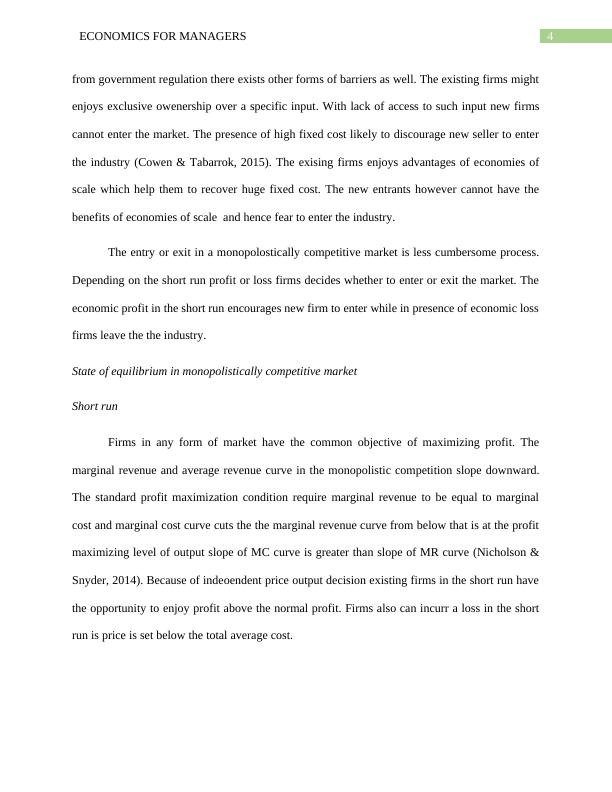
5ECONOMICS FOR MANAGERS
Figure 1: Monopolistically competitive firm enjoying supernormal profit
(Source: as created by Author)
Figure 1: Monopolistically competitive firm enjoying supernormal profit
(Source: as created by Author)
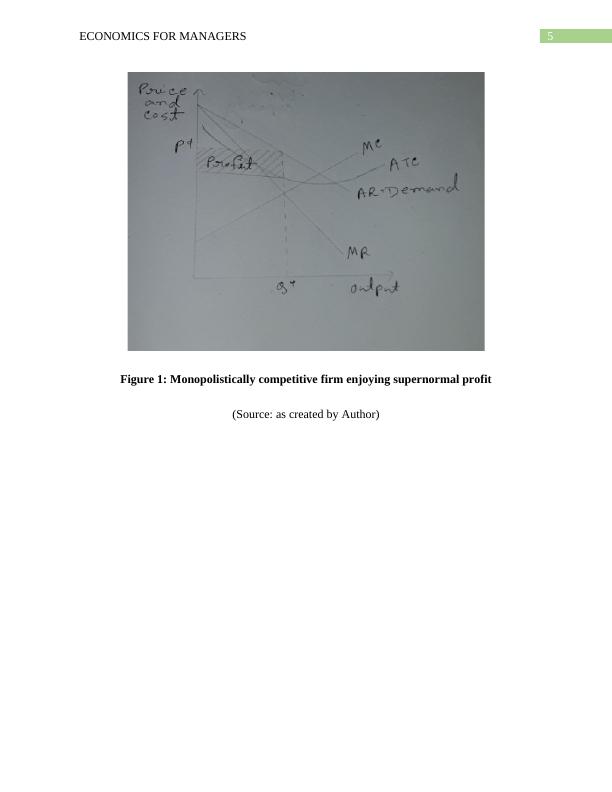
End of preview
Want to access all the pages? Upload your documents or become a member.
Related Documents
International Trade and Enterpriselg...
|12
|2702
|50
Oligopoly in US Cellphone Marketlg...
|16
|3705
|434
Monopolistic Competition and Oligopoly Marketslg...
|10
|849
|321
Theoretical Framework of Economics - PDFlg...
|20
|4226
|246
An Analysis on Cartellg...
|10
|2269
|457
Types of Market Structure: Perfect Competition, Monopoly, Oligopoly, Monopolistic Competitionlg...
|19
|4224
|23
